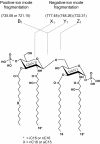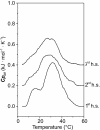Physicochemical characterization of the endotoxins from Coxiella burnetii strain Priscilla in relation to their bioactivities
- PMID: 14715092
- PMCID: PMC331395
- DOI: 10.1186/1471-2091-5-1
Physicochemical characterization of the endotoxins from Coxiella burnetii strain Priscilla in relation to their bioactivities
Abstract
Background: Coxiella burnetii is the etiological agent of Q fever found worldwide. The microorganism has like other Gram-negative bacteria a lipopolysaccharide (LPS, endotoxin) in its outer membrane, which is important for the pathogenicity of the bacteria. In order to understand the biological activity of LPS, a detailed physico-chemical analysis of LPS is of utmost importance.
Results: The lipid A moiety of LPS is tetraacylated and has longer (C-16) acyl chains than most other lipid A from enterobacterial strains. The two ester-linked 3-OH fatty acids found in the latter are lacking. The acyl chains of the C. burnetii endotoxins exhibit a broad melting range between 5 and 25 degrees C for LPS and 10 and 40 degrees C for lipid A. The lipid A moiety has a cubic inverted aggregate structure, and the inclination angle of the D-glucosamine disaccharide backbone plane of the lipid A part with respect to the membrane normal is around 40 degrees. Furthermore, the endotoxins readily intercalate into phospholipid liposomes mediated by the lipopolysaccharide-binding protein (LBP). The endotoxin-induced tumor necrosis factor alpha (TNFalpha) production in human mononuclear cells is one order of magnitude lower than that found for endotoxins from enterobacterial strains, whereas the same activity as in the latter compounds is found in the clotting reaction of the Limulus amebocyte lysate assay.
Conclusions: Despite a considerably different chemical primary structure of the C. burnetii lipid A in comparison with enterobacterial lipid A, the data can be well understood by applying the previously presented conformational concept of endotoxicity, a conical shape of the lipid A moiety of LPS and a sufficiently high inclination of the sugar backbone plane with respect to the membrane plane. Importantly, the role of the acyl chain fluidity in modulating endotoxicity now becomes more evident.
Figures







Similar articles
-
Interaction of hemoglobin with enterobacterial lipopolysaccharide and lipid A. Physicochemical characterization and biological activity.Eur J Biochem. 2001 Aug;268(15):4233-42. doi: 10.1046/j.1432-1327.2001.02338.x. Eur J Biochem. 2001. PMID: 11488917
-
Biophysical characterization of lipopolysaccharide and lipid A inactivation by lactoferrin.Biol Chem. 2001 Aug;382(8):1215-25. doi: 10.1515/BC.2001.152. Biol Chem. 2001. PMID: 11592403
-
Biophysical characterization of the interaction of Limulus polyphemus endotoxin neutralizing protein with lipopolysaccharide.Eur J Biochem. 2004 May;271(10):2037-46. doi: 10.1111/j.1432-1033.2004.04134.x. Eur J Biochem. 2004. PMID: 15128313
-
A case for an endotoxic conformation.Prog Clin Biol Res. 1994;388:17-30. Prog Clin Biol Res. 1994. PMID: 7831357 Review.
-
The chemical structure of bacterial endotoxin in relation to bioactivity.Immunobiology. 1993 Apr;187(3-5):169-90. doi: 10.1016/S0171-2985(11)80338-4. Immunobiology. 1993. PMID: 8330896 Review.
Cited by
-
Evasion and interference: intracellular pathogens modulate caspase-dependent inflammatory responses.Nat Rev Microbiol. 2016 Jun;14(6):346-59. doi: 10.1038/nrmicro.2016.50. Epub 2016 May 13. Nat Rev Microbiol. 2016. PMID: 27174147 Review.
-
Lipid A heterogeneity and its role in the host interactions with pathogenic and commensal bacteria.Microlife. 2022 Jun 10;3:uqac011. doi: 10.1093/femsml/uqac011. eCollection 2022. Microlife. 2022. PMID: 37223360 Free PMC article. Review.
-
Susceptibility, Immunity, and Persistent Infection Drive Endemic Cycles of Coxiellosis on Dairy Farms.Animals (Basel). 2024 Mar 29;14(7):1056. doi: 10.3390/ani14071056. Animals (Basel). 2024. PMID: 38612295 Free PMC article.
-
Physicochemical characterization of biological and synthetic forms of two lipid A-based TLR4 agonists.Heliyon. 2023 Jul 8;9(7):e18119. doi: 10.1016/j.heliyon.2023.e18119. eCollection 2023 Jul. Heliyon. 2023. PMID: 37483830 Free PMC article.
-
Coxiella burnetii Lipopolysaccharide: What Do We Know?Int J Mol Sci. 2017 Nov 23;18(12):2509. doi: 10.3390/ijms18122509. Int J Mol Sci. 2017. PMID: 29168790 Free PMC article. Review.
References
-
- Marrie TJ. Acute Q fever. In: Marrie TJ, editor. In Q Fever The Disease. I. Boca Raton: CRC Press; 1990. pp. 125–160.
-
- Raoult D, Raza A, Marrie TJ. Q fever endocarditis and other forms of chronic Q fever. In: Marrie TJ, editor. In Q Fever The Disease. Boca Raton: CRC Press; 1990. pp. 179–199.
-
- Williams JC, Waag DM. Antigens, virulence factors, and biological response modifiers of Coxiella burnetii: Strategies for vaccine development. In: Williams JC, Thompson HA, editor. In Q Fever, The Biology of Coxiella burnetii. Boca Raton: CRC Press; 1991. pp. 175–222.
-
- Gajdošová E, Kováèová E, Toman R, Škultéty L', Lukáèová M, Kazár J. Immunogenicity of Coxiella burnetii whole cells and their outer membrane components. Acta Virol. 1994;38:339–344. - PubMed
-
- Dellacasagrande J, Ghigo E, Machergui-El Hammami S, Toman R, Raoult D, Capo C, Mege JL. αV β3 Integrin and bacterial lipopolysaccharide are involved in Coxiella burnetii-stimulated production of tumor necrosis factor by human monocytes. Infect Immun. 2000;68:5673–5678. doi: 10.1128/IAI.68.10.5673-5678.2000. - DOI - PMC - PubMed
Publication types
MeSH terms
Substances
LinkOut - more resources
Full Text Sources
Miscellaneous

